目录
哈希表
哈希(hash)⼜称散列,是⼀种组织数据的⽅式。哈希表也是一种数据结构。从译名来看,有散乱排列的意思。本质就是通过哈希 函数把关键字Key跟存储位置建⽴⼀个 映射关系 ,查找时通过这个哈希函数计算出Key存储的位置,进⾏快速查找,时间复杂度是O(1)
1.哈希表概念
1.1直接定址法
直接定址法可以开启对哈希的认知。当关键字的范围⽐较集中时,直接定址法就是⾮常简单⾼效的⽅法,⽐如⼀组关键字都在[0,99]之间, 那么我们开⼀个100个数的数组,每个关键字的值直接就是存储位置的下标,这个就是直接定址法。但是这种方法有很大的局限性,数据范围太大这种方法就不适用了
26个字母的直接定址法
class Solution {
public :
int firstUniqChar (string s) {
// 每个字⺟的ascii 码 -'a' 的 ascii 码作为下标映射到 count 数组,数组中存储出现的次数
int count[ 26 ] = { 0 };
// 统计次数
for ( auto ch : s)
{
count[ch- 'a' ]++;
}
for ( size_t i = 0 ; i < s. size (); ++i)
{
if (count[s[i]- 'a' ] == 1 )
return i;
}
return -1 ;
}
};
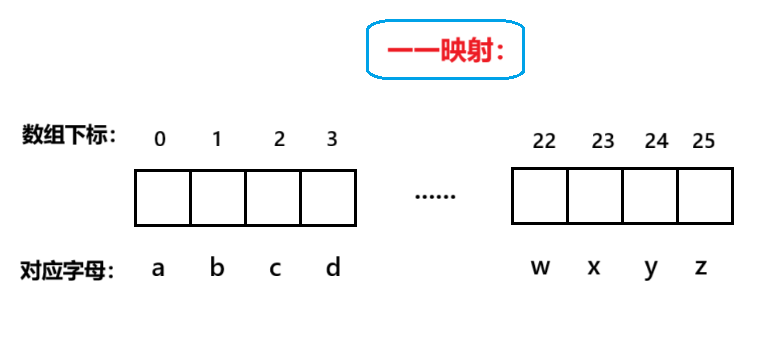
1.2哈希冲突
数据范围是[0, 9999]的N个值,我们要映射到⼀个M个空间的数组中(⼀般情况下M >= N),那么就要借助 哈希函数 (hash function)hf,关键字key被放到数组的h(key)位置,且h(key)计算出的值必须在[0, M)之间
不过问题就是,两个不同的key可能会映射到同⼀个位置去,这种问题我们叫做哈希冲突,或者哈希碰撞。理想情况是找出⼀个好的哈希函数避免冲突,但是实际场景中,冲突是不可避免的,
所以我们尽可能设计出优秀的哈希函数,减少冲突的次数,同时也要去设计出解决冲突的⽅案

上面这个实例中,19,30,52,63这几个数经过哈希函数处理,h(key)= 8,这几个数就是冲突
1.3负载因子
哈希表中已经映射存储了N个值,哈希表的⼤⼩为M,负载因子 = ,有时叫做载荷因⼦/装载因⼦等
负载因⼦越⼤,哈希冲突的概率越⾼,空间 利⽤率越⾼;负载因⼦越⼩,哈希冲突的概率越低,空间利⽤率越低
1.4哈希函数
哈希函数的作用就是在哈希表中将数据尽量的均匀分开
1.4.1除法散列法/除留余数法
除法散列法是很常用的方法,假设哈希表的⼤⼩为M,那么通过 key除以M的余数作为 映射位置的下标
除留余数法的哈希函数为:h(key) = key % M
使⽤除法散列法时,要尽量避免M为某些值,如2的幂,10的幂等
因为cpu使用的是二进制,M=时,相当于只保留了key的后x位,M的二进制的x位以外的位数并没有参与运算;自然数用的是十进制,同理,也会造成同样的问题
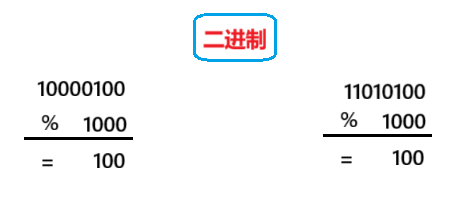
1.4.2乘法散列法
这个方法不是很常用,乘法散列法对哈希表⼤⼩M没有要求,他的⼤思路第⼀步:⽤关键字 K 乘上常数 A (0<A<1),并抽
取出 k*A 的⼩数部分。第⼆步:后再⽤M乘以k*A 的⼩数部分,再向下取整
h ( key ) = floor ( M × (( A × key)%1.0)),其中floor表⽰对表达式进⾏下取整,A∈(0,1)
1.4.3全域散列法
这个方法了解即可,如果存在⼀个恶意的对⼿,他针对我们提供的散列函数,特意构造出⼀个发⽣严重冲突的数据集,⽐如,让所有关键字全部落⼊同⼀个位置中。这种情况是可以存在的,只要散列函数是公开且确定的,就可以实现此攻击。解决⽅法⾃然是⻅招拆招,给散列函数增加随机性,攻击者就⽆法找出确定可以导致最坏情况的数据。这种⽅法叫做全域散列
h ab ( key ) = (( a × key + b )% P )%M, P需要选⼀个⾜够⼤的质数,a可以随机选[1,P-1]之间的
任意整数,b可以随机选[0,P-1]之间的任意整数,这些函数构成了⼀个P*(P-1)组全域散列函数组
这样就可以防止黑客等恶意攻击
2.处理哈希冲突
处理哈希冲突有两大类方法,开放定址法,链地址法
2.1开放定址法
开放定址法的哈希表的结构是vector中存放Node节点的形式
意味着一个在哈希表的vector当中,一个索引底下只能存放一个Node,其他的数据需要在他周围另找空间,所以线性探测、二次探测、双重探测出现了

在开放定址法中所有的元素都放到哈希表⾥,当⼀个关键字key⽤哈希函数计算出的位置冲突了,则按 照某种规则找到⼀个没有存储数据的位置进⾏存储,开放定址法中负载因⼦⼀定是⼩于的。这⾥的规则主要有两种: 线性探测、⼆次探测
线性探测
从发⽣冲突的位置开始,依次线性向后探测,直到寻找到下⼀个没有存储数据的位置为⽌,如果⾛
到哈希表尾,则回绕到哈希表头的位置
h ( key ) = hash 0 = key % *M,*hash0位置冲突了,则线性探测公式为:
hc ( key , i ) = hashi = ( hash 0 + i ) % M,i = {1, 2, 3, ..., M− 1}, 由于 负载因⼦⼩于1, 则最多探测M-1次,⼀定能找到⼀个存储key的位置
下⾯演⽰ {19,30,5,36,13,20,21,12} 等这⼀组值映射到M=11的表中
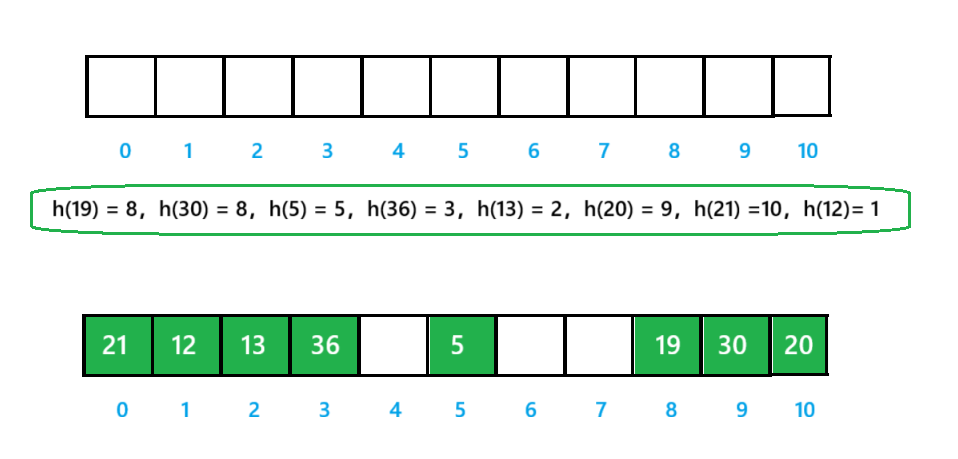
二次探测
从发⽣冲突的位置开始,依次左右按⼆次⽅跳跃式探测,直到寻找到下⼀个没有存储数据的位置为
⽌,如果往右⾛到哈希表尾,则回绕到哈希表头的位置;如果往左⾛到哈希表头,则回绕到哈希表
尾的位置
h ( key ) = hash 0 = key % M , hash0位置冲突了,则⼆次探测公式为:
hc ( key , i ) = hashi = ( hash 0 ± ) % M , i = {1, 2, 3, ...,
}
⼆次探测当 hashi = ( hash 0 − i 2 )% M 时,当hashi<0时,需要hashi += M
下⾯演⽰ {19,30,52,63,11,22} 等这⼀组值映射到M=11的表中
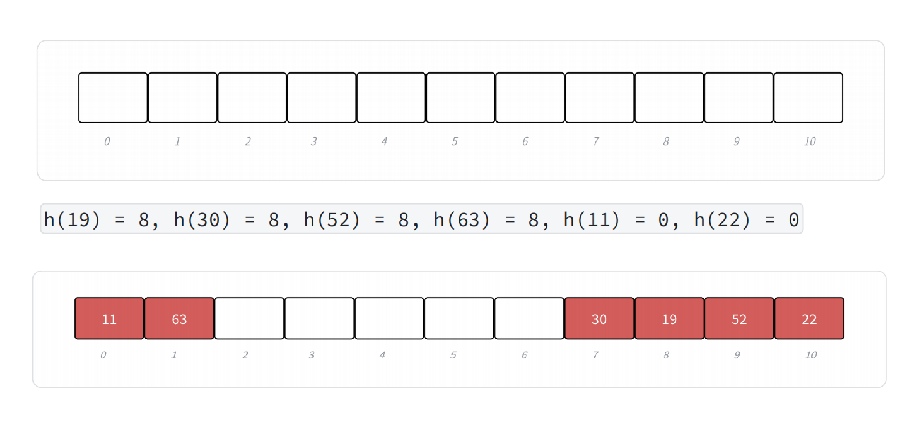
开放定址法代码
其中的HashFunc是用来计算数据在哈希表中数组的索引,是哈希表里面的功能函数,并且是仿函数,还使用了模板的特化专门对string处理
并非我们所说的将数据均匀分散开的哈希函数
cpp
namespace open_address
{
#include<string>
#include<vector>
#include<algorithm>
using namespace std;
enum State
{
EXIST,
EMPTY,
DELETE
};
template<class K, class V>
struct HashData
{
pair<K, V> _kv;
State _state = EMPTY;
};
template<class K>
struct HashFunc
{
size_t operator()(const K& key)
{
return (size_t)key;
}
};
//模板的特化,处理string
template<>
struct HashFunc<string>
{
size_t ret = 0;
size_t operator()(const string& key)
{
for (auto e : key)
{
ret *= 31;
ret += e;
}
return ret;
}
};
template<class K, class V, class Hash = HashFunc<K>>
class HashTable
{
public:
inline unsigned long __stl_next_prime(unsigned long n)
{
// Note: assumes long is at least 32 bits.
static const int __stl_num_primes = 28;
static const unsigned long __stl_prime_list[__stl_num_primes] =
{
53, 97, 193, 389, 769,
1543, 3079, 6151, 12289, 24593,
49157, 98317, 196613, 393241, 786433,
1572869, 3145739, 6291469, 12582917, 25165843,
50331653, 100663319, 201326611, 402653189, 805306457,
1610612741, 3221225473, 4294967291
};
const unsigned long* first = __stl_prime_list;
const unsigned long* last = __stl_prime_list +
__stl_num_primes;
const unsigned long* pos = lower_bound(first, last, n);
return pos == last ? *(last - 1) : *pos;
}
HashTable()
{
_tables.resize(__stl_next_prime(0));
}
bool Insert(const pair<K, V>& kv)
{
if (Find(kv.first))
return false;
// 负载因⼦⼤于0.7就扩容
if (_n * 10 / _tables.size() >= 7)
{
// 这⾥利⽤类似深拷⻉现代写法的思想插⼊后交换解决
HashTable<K, V, Hash> newHT;
newHT._tables.resize(__stl_next_prime(_tables.size() + 1));
for (size_t i = 0; i < _tables.size(); i++)
{
if (_tables[i]._state == EXIST)
{
newHT.Insert(_tables[i]._kv);
}
}
_tables.swap(newHT._tables);
}
Hash hash;
size_t hash0 = hash(kv.first) % _tables.size();
size_t hashi = hash0;
size_t i = 1;
while (_tables[hashi]._state == EXIST)
{
// 线性探测
hashi = (hash0 + i) % _tables.size();
// ⼆次探测就变成 +- i^2
++i;
}
_tables[hashi]._kv = kv;
_tables[hashi]._state = EXIST;
++_n;
return true;
}
HashData<K, V>* Find(const K& key)
{
Hash hash;
size_t hash0 = hash(key) % _tables.size();
size_t hashi = hash0;
size_t i = 1;
while (_tables[hashi]._state != EMPTY)
{
if (_tables[hashi]._state == EXIST
&& _tables[hashi]._kv.first == key)
{
return &_tables[hashi];
}
// 线性探测
hashi = (hash0 + i) % _tables.size();
++i;
}
return nullptr;
}
bool Erase(const K& key)
{
HashData<K, V>* ret = Find(key);
if (ret == nullptr)
{
return false;
}
else
{
ret->_state = DELETE;
--_n;
return true;
}
}
private:
vector<HashData<K, V>> _tables;
size_t _n = 0; // 表中存储数据个数
};
}2.2链地址法(哈希桶)
开放定址法中所有的元素都放到哈希表⾥,链地址法中所有的数据不再直接存储在哈希表中,哈希表 中存储⼀个指针,没有数据映射这个位置时,这个指针为空,有多个数据映射到这个位置时,我们把 这些冲突的数据链接成⼀个链表,挂在哈希表这个位置下⾯,链地址法也叫做拉链法或者哈希桶
将 {19,30,5,36,13,20,21,12,24,96} 等这⼀组值以哈希桶的方式映射到M=11的表中
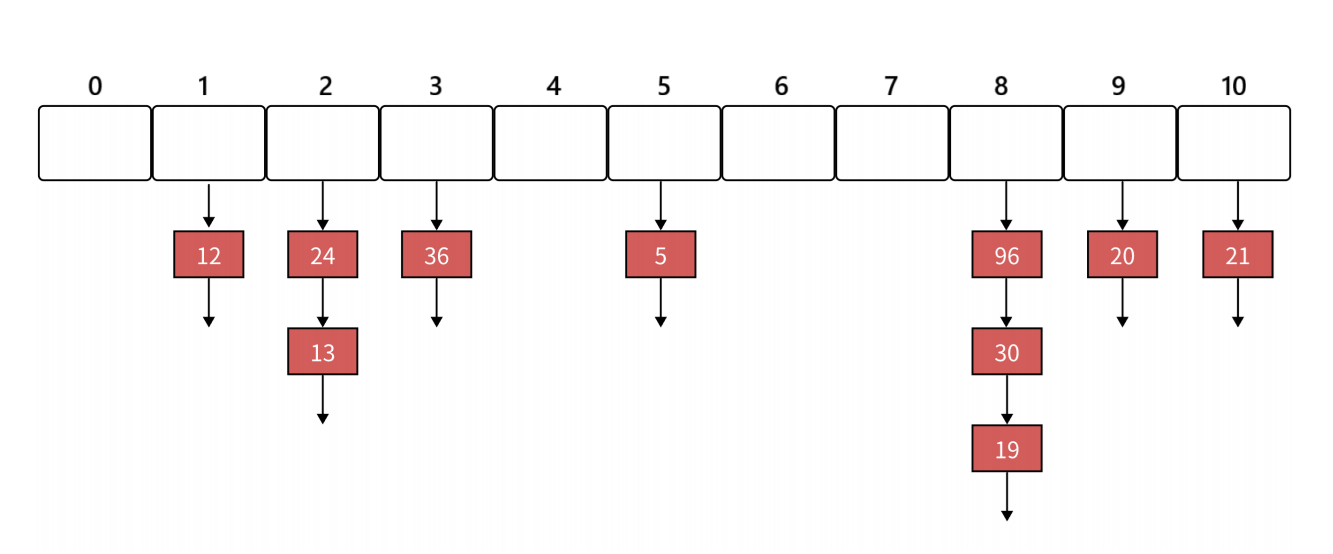
链地址法代码:
cpp
namespace hash_bucket
{
#include<string>
#include<vector>
#include<algorithm>
using namespace std;
template<class K, class V>
struct HashNode
{
pair<K, V> _kv;
HashNode<K, V>* _next;
HashNode(const pair<K, V>& kv)
:_kv(kv)
, _next(nullptr)
{}
};
template<class K>
struct HashFunc
{
size_t operator()(const K& key)
{
return (size_t)key;
}
};
template<>
struct HashFunc<string>
{
size_t ret = 0;
size_t operator()(const string& key)
{
for (auto e : key)
{
ret *= 31;
ret += e;
}
return ret;
}
};
template<class K, class V, class Hash = HashFunc<K>>
class HashTable
{
typedef HashNode<K, V> Node;
inline unsigned long __stl_next_prime(unsigned long n)
{
static const int __stl_num_primes = 28;
static const unsigned long __stl_prime_list[__stl_num_primes] =
{
53, 97, 193, 389, 769,
1543, 3079, 6151, 12289, 24593,
49157, 98317, 196613, 393241, 786433,
1572869, 3145739, 6291469, 12582917, 25165843,
50331653, 100663319, 201326611, 402653189, 805306457,
1610612741, 3221225473, 4294967291
};
const unsigned long* first = __stl_prime_list;
const unsigned long* last = __stl_prime_list +
__stl_num_primes;
const unsigned long* pos = lower_bound(first, last, n);
return pos == last ? *(last - 1) : *pos;
}
public:
HashTable()
{
_tables.resize(__stl_next_prime(0), nullptr);
}
~HashTable()
{
// 依次把每个桶释放
for (size_t i = 0; i < _tables.size(); i++)
{
Node* cur = _tables[i];
while (cur)
{
Node* next = cur->_next;
delete cur;
cur = next;
}
_tables[i] = nullptr;
}
}
bool Insert(const pair<K, V>& kv)
{
Hash hs;
size_t hashi = hs(kv.first) % _tables.size();
// 负载因⼦==1扩容
if (_n == _tables.size())
{
// 这⾥如果使⽤上⾯的⽅法,扩容时创建新的结点,后⾯还要使⽤就结点,浪费了
// 下⾯的⽅法,直接移动旧表的结点到新表,效率更好
vector<Node*> newtables(__stl_next_prime(_tables.size() + 1), nullptr);
for (size_t i = 0; i < _tables.size(); i++)
{
Node* cur = _tables[i];
while (cur)
{
Node* next = cur->_next;
// 旧表中节点,挪动新表重新映射的位置
size_t hashi = hs(cur->_kv.first) %
newtables.size();
// 头插到新表
cur->_next = newtables[hashi];
newtables[hashi] = cur;
cur = next;
}
_tables[i] = nullptr;
}
_tables.swap(newtables);
}
// 头插
Node* newnode = new Node(kv);
newnode->_next = _tables[hashi];
_tables[hashi] = newnode;
++_n;
return true;
}
Node* Find(const K& key)
{
Hash hs;
size_t hashi = hs(key) % _tables.size();
Node * cur = _tables[hashi];
while (cur)
{
if (cur->_kv.first == key)
{
return cur;
}
cur = cur->_next;
}
return nullptr;
}
bool Erase(const K& key)
{
Hash hs;
size_t hashi = hs(key) % _tables.size();
Node* prev = nullptr;
Node* cur = _tables[hashi];
while (cur)
{
if (cur->_kv.first == key)
{
if (prev == nullptr)
{
_tables[hashi] = cur->_next;
}
else
{
prev->_next = cur->_next;
}
delete cur;
--_n;
return true;
}
prev = cur;
cur = cur->_next;
}
return false;
}
private:
vector<Node*> _tables; // 指针数组
size_t _n = 0; // 表中存储数据个数
};
}unordered_map
底层使用的是哈希表的unordered_map,一般是哈希桶实现的使用了哈希表进行 封装
实现 unordered_map的方法有多种,如红黑树法(java)
因为底层使用的是哈希表,unordered_map的增删查改效率是O(1)
unordered_map的实现
需要实现迭代器,所以底层的HashBuckte的接口也要随着更改
Myunodered_map可执行代码:
cpp
#include <iostream>
#include <vector>
#include <string>
#include <algorithm> // for lower_bound
using namespace std;
// 哈希函数模板(默认支持数值类型)
template<class K>
struct HashFunc
{
size_t operator()(const K& key) const
{
return (size_t)key;
}
};
// 字符串哈希函数特化
template<>
struct HashFunc<string>
{
size_t operator()(const string& s) const
{
size_t hash = 0;
for (auto ch : s)
{
hash = hash * 31 + ch;
}
return hash;
}
};
// 素数表(用于哈希表扩容,保证桶数为素数)
inline unsigned long __stl_next_prime(unsigned long n)
{
static const int __stl_num_primes = 28;
static const unsigned long __stl_prime_list[__stl_num_primes] = {
53, 97, 193, 389, 769,
1543, 3079, 6151, 12289, 24593,
49157, 98317, 196613, 393241, 786433,
1572869, 3145739, 6291469, 12582917, 25165843,
50331653, 100663319, 201326611, 402653189, 805306457,
1610612741, 3221225473, 4294967291
};
const unsigned long* first = __stl_prime_list;
const unsigned long* last = __stl_prime_list + __stl_num_primes;
const unsigned long* pos = lower_bound(first, last, n);
return pos == last ? *(last - 1) : *pos;
}
// 哈希桶节点结构
template<class T>
struct HashNode
{
T _data;
HashNode<T>* _next;
HashNode(const T& data)
: _data(data)
, _next(nullptr)
{}
};
// 哈希表前置声明(供迭代器访问私有成员)
template<class K, class T, class KeyOfT, class Hash = HashFunc<K>>
class HashTable;
// 哈希表迭代器
template<class K, class T, class Ref, class Ptr, class KeyOfT, class Hash>
struct HTIterator
{
typedef HashNode<T> Node;
typedef HashTable<K, T, KeyOfT, Hash> HT;
typedef HTIterator<K, T, Ref, Ptr, KeyOfT, Hash> Self;
Node* _node; // 当前指向的节点
const HT* _ht; // 指向哈希表(用于遍历下一个桶)
HTIterator(Node* node, const HT* ht)
: _node(node)
, _ht(ht)
{}
// 解引用运算符
Ref operator*() const
{
return _node->_data;
}
// 箭头运算符
Ptr operator->() const
{
return &_node->_data;
}
// 不等比较运算符
bool operator!=(const Self& s) const
{
return _node != s._node;
}
// 前置++运算符(遍历下一个节点)
Self& operator++()
{
if (_node->_next)
{
// 当前桶有下一个节点,直接移动
_node = _node->_next;
}
else
{
// 当前桶遍历完毕,找下一个非空桶
KeyOfT kot;
Hash hash;
size_t hashi = hash(kot(_node->_data)) % _ht->_tables.size();
++hashi;
// 遍历后续桶,直到找到非空桶或结束
while (hashi < _ht->_tables.size())
{
if (_ht->_tables[hashi])
{
_node = _ht->_tables[hashi];
break;
}
++hashi;
}
// 所有桶遍历完毕,指向nullptr(对应end())
if (hashi == _ht->_tables.size())
{
_node = nullptr;
}
}
return *this;
}
};
// 哈希桶法哈希表(核心类)
template<class K, class T, class KeyOfT, class Hash>
class HashTable
{
// 迭代器类友元声明(允许访问私有成员_tables)
template<class K1, class T1, class Ref1, class Ptr1, class KeyOfT1, class Hash1>
friend struct HTIterator;
typedef HashNode<T> Node;
public:
// 迭代器类型定义
typedef HTIterator<K, T, T&, T*, KeyOfT, Hash> Iterator;
typedef HTIterator<K, T, const T&, const T*, KeyOfT, Hash> ConstIterator;
// 构造函数(初始化桶数为最小素数)
HashTable()
: _tables(__stl_next_prime(0))
, _n(0)
{}
// 析构函数(释放所有节点和桶)
~HashTable()
{
for (size_t i = 0; i < _tables.size(); i++)
{
Node* cur = _tables[i];
while (cur)
{
Node* next = cur->_next;
delete cur;
cur = next;
}
_tables[i] = nullptr; // 避免野指针
}
}
// 迭代器相关接口
Iterator Begin()
{
if (_n == 0)
return End();
// 找到第一个非空桶的第一个节点
for (size_t i = 0; i < _tables.size(); i++)
{
if (_tables[i])
{
return Iterator(_tables[i], this);
}
}
return End();
}
Iterator End()
{
return Iterator(nullptr, this);
}
ConstIterator Begin() const
{
if (_n == 0)
return End();
for (size_t i = 0; i < _tables.size(); i++)
{
if (_tables[i])
{
return ConstIterator(_tables[i], this);
}
}
return End();
}
ConstIterator End() const
{
return ConstIterator(nullptr, this);
}
// 插入元素(返回迭代器和插入结果)
pair<Iterator, bool> Insert(const T& data)
{
KeyOfT kot;
// 先查找,避免重复插入
Iterator it = Find(kot(data));
if (it != End())
return { it, false };
// 负载因子 == 1 时扩容(桶数翻倍并取素数)
if (_n == _tables.size())
{
vector<Node*> newTable(__stl_next_prime(_tables.size() + 1));
// 旧桶节点重新哈希到新桶
for (size_t i = 0; i < _tables.size(); i++)
{
Node* cur = _tables[i];
while (cur)
{
Node* next = cur->_next;
// 重新计算新桶位置
size_t hashi = Hash()(kot(cur->_data)) % newTable.size();
// 头插法插入新桶
cur->_next = newTable[hashi];
newTable[hashi] = cur;
cur = next;
}
_tables[i] = nullptr; // 旧桶置空
}
_tables.swap(newTable); // 交换新旧桶数组
}
// 插入新节点(头插法)
size_t hashi = Hash()(kot(data)) % _tables.size();
Node* newnode = new Node(data);
newnode->_next = _tables[hashi];
_tables[hashi] = newnode;
++_n;
return { Iterator(newnode, this), true };
}
// 查找元素(返回迭代器)
Iterator Find(const K& key)
{
KeyOfT kot;
Hash hash;
size_t hashi = hash(key) % _tables.size();
Node* cur = _tables[hashi];
// 遍历当前桶的所有节点
while (cur)
{
if (kot(cur->_data) == key)
{
return Iterator(cur, this);
}
cur = cur->_next;
}
return End(); // 未找到
}
// 删除元素(返回是否成功)
bool Erase(const K& key)
{
KeyOfT kot;
Hash hash;
size_t hashi = hash(key) % _tables.size();
Node* prev = nullptr;
Node* cur = _tables[hashi];
// 遍历当前桶,查找并删除目标节点
while (cur)
{
if (kot(cur->_data) == key)
{
// 处理头节点和中间节点的删除
if (prev == nullptr)
{
_tables[hashi] = cur->_next;
}
else
{
prev->_next = cur->_next;
}
delete cur;
--_n;
return true;
}
prev = cur;
cur = cur->_next;
}
return false; // 未找到
}
private:
vector<Node*> _tables; // 桶数组(存储节点指针)
size_t _n = 0; // 有效元素个数
};
// 基于哈希桶法的unordered_map实现
template<class K, class V, class Hash = HashFunc<K>>
class unordered_map
{
// 提取键的仿函数(从pair<const K, V>中获取K)
struct MapKeyOfT
{
const K& operator()(const pair<const K, V>& kv) const
{
return kv.first;
}
};
public:
// 迭代器类型定义(复用哈希表的迭代器)
typedef typename HashTable<K, pair<const K, V>, MapKeyOfT, Hash>::Iterator iterator;
typedef typename HashTable<K, pair<const K, V>, MapKeyOfT, Hash>::ConstIterator const_iterator;
// 迭代器接口
iterator begin()
{
return _ht.Begin();
}
iterator end()
{
return _ht.End();
}
const_iterator begin() const
{
return _ht.Begin();
}
const_iterator end() const
{
return _ht.End();
}
// []运算符(插入或访问元素)
V& operator[](const K& key)
{
pair<iterator, bool> ret = insert({ key, V() });
return ret.first->second;
}
// 插入元素(适配pair<K, V>到pair<const K, V>)
pair<iterator, bool> insert(const pair<K, V>& kv)
{
return _ht.Insert({ kv.first, kv.second });
}
// 查找元素
iterator Find(const K& key)
{
return _ht.Find(key);
}
// 删除元素
bool Erase(const K& key)
{
return _ht.Erase(key);
}
private:
HashTable<K, pair<const K, V>, MapKeyOfT, Hash> _ht; // 哈希表对象
};
// 测试函数(验证unordered_map功能)
void test_unordered_map()
{
unordered_map<string, string> dict;
// 插入元素(包含重复插入)
dict.insert({ "sort", "排序" });
dict.insert({ "字符串", "string" });
dict.insert({ "sort", "排序" }); // 重复插入,返回失败
dict.insert({ "left", "左边" });
dict.insert({ "right", "右边" });
// 使用[]修改和插入元素
dict["left"] = "左边,剩余"; // 修改已有元素
dict["insert"] = "插入"; // 插入新元素
dict["string"]; // 插入默认值(空字符串)
// 遍历输出
cout << "所有元素:" << endl;
for (auto& kv : dict)
{
cout << kv.first << ":" << kv.second << endl;
}
cout << endl;
// 查找测试
auto it = dict.Find("insert");
if (it != dict.end())
{
cout << "找到元素:" << it->first << ":" << it->second << endl;
}
cout << endl;
// 删除测试
dict.Erase("right");
cout << "删除right后:" << endl;
for (auto& kv : dict)
{
cout << kv.first << ":" << kv.second << endl;
}
}
int main()
{
test_unordered_map();
return 0;
}